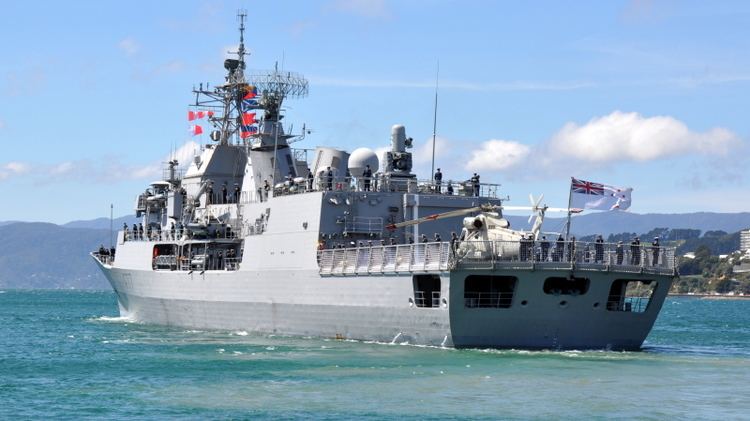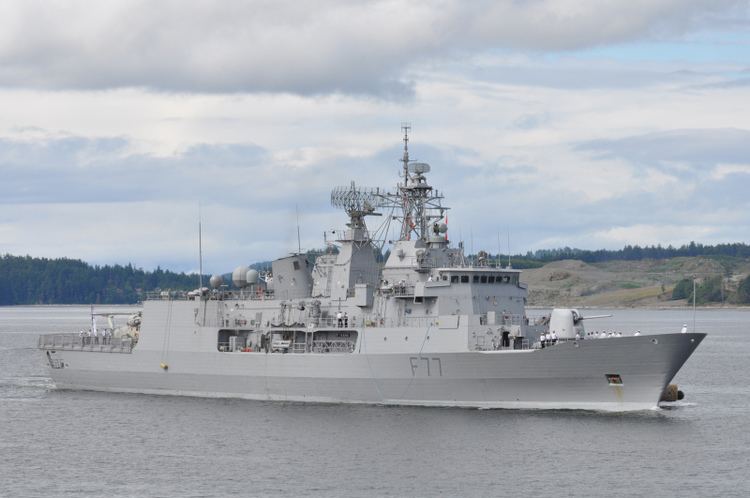Name HMNZS Te Kaha Builder Tenix Defence Systems Commissioned 22 July 1997 Construction started 19 September 1994 Draft 4 m | Namesake Kaha Laid down 19 September 1994 Length 118 m Launched 22 July 1995 | |
 | ||
Motto "He Ponanga Kaha" (service with strength) | ||
HMNZS Te Kaha (F77) is one of ten Anzac class frigates, and one of two serving in the Royal New Zealand Navy (RNZN). The name Te Kaha is Māori, meaning 'fighting prowess' or 'strength' (for further information on this term, see Kaha).
Contents

Design and construction

During the mid-1980s, the RNZN began considering the replacement of their four Leander class frigates. Around the same time, a deterioration in New Zealand-United States relations forced the New Zealand government to improve ties with local nations. As the Royal Australian Navy was seeking to replace their River class destroyer escorts with ships nearly identical to what the RNZN wanted, the two nations decided to collaborate on the acquisition in early 1987. Tenders had been requested in 1986, and 12 ship designs (including an airship) were submitted. By August 1987, these were narrowed down in October to Blohm + Voss's MEKO 200 design, the M class (later Karel Doorman class) offered by Royal Schelde, and a scaled-down Type 23 frigate proposed by Yarrow Shipbuilders. In 1989, the Australian government announced that Melbourne-based shipbuilder AMECON (which became Tenix Defense) would build the modified MEKO 200 design. However, the decision to buy the frigates had been highly controversial in New Zealand, primarily because of the cost of purchasing frigate-type ships, plus the idea that the high-capability warships would be too few and too overspecialised for the fisheries and Economic Exclusion Zone (EEZ) patrols expected to be the RNZN's core operations. Despite ongoing debate, the New Zealand government agreed to purchase two frigates in addition to the RAN's eight, and had an option for two more. This option expired in 1997 without New Zealand exercising it; there were proposals to buy a new or second-hand Anzac outside the terms of the original contract, but a lack of political support stopped this developing, and the number built for the RNZN remained at two. The drop in capability and the issue of tying up the Anzacs on EEZ patrols when they could be deployed more suitably elsewhere were factors leading to the RNZN's Project Protector acquisition program.

The Anzacs are based on Blohm + Voss' MEKO 200 PN (or Vasco da Gama class) frigates, modified to meet Australian and New Zealand specifications and maximise the use of locally built equipment. Each frigate has a 3,600-tonne (3,500-long-ton; 4,000-short-ton) full load displacement. The ships are 109 metres (358 ft) long at the waterline, and 118 metres (387 ft) long overall, with a beam of 14.8 metres (49 ft), and a full load draught of 4.35 metres (14.3 ft). The ships are fitted with a Combined Diesel or Gas (CODOG) propulsion machinery layout, consisting of two controllable-pitch propellers driven by a single General Electric LM2500-30 gas turbine and two MTU diesel engines: initially the TB83 model, but these were replaced in 2009 with more powerful TB93s. Maximum speed is 27 knots (50 km/h; 31 mph), and maximum range is over 6,000 nautical miles (11,000 km; 6,900 mi) at 18 knots (33 km/h; 21 mph); about 50% greater than other MEKO 200 designs. The standard ship's company of an Anzac consists of 22 officers and 141 sailors.

As designed, the main armament for the frigate is a 5-inch 54 calibre Mark 45 gun, supplemented by an eight-cell Mark 41 vertical launch system for RIM-7 Sea Sparrow surface to air missiles, two 12.7-millimetre (0.50 in) machine guns, and two Mark 32 triple torpedo tube sets firing Mark 46 torpedoes. They were also designed for but not with a close-in weapons system (a Phalanx CIWS installed shortly after the frigate's completion, supplemented by two Mini Typhoons from 2006 onwards), two quad-canister Harpoon missile launchers, and a second Mark 41 launcher (neither of which have been added to the New Zealand ships). The New Zealand Anzacs initially operated with a Westland Wasp helicopter, which were later replaced by Kaman SH-2 Seasprites, then Kaman SH-2G Super Seasprite helicopters.
Te Kaha was laid down at Williamstown, Victoria on 19 September 1994. The ship was assembled from six hull modules and six superstructure modules; the superstructure modules were fabricated in Whangarei, New Zealand, and hull modules were built at both Williamstown and Newcastle, New South Wales, with final integration at Williamstown. She was launched on 22 July 1995, and commissioned into the RNZN on 22 July 1997. In early 2002, microscopic cracks in Te Kaha's bilge keel and hull plating were discovered. This problem, which was common to the first four ships of the Anzac class, was later rectified.
Operational history
In 1999, Te Kaha pursued Patagonian Toothfish poachers in the Ross Dependency, participated in the INTERFET multinational deployment to East Timor from 19 to 26 September, and operated as part of the Multinational Interception Force in the Persian Gulf.
The frigate was also involved in the Solomon Islands conflict during 2000 and 2001, with several periods as guardship at the capital, Honiara.
In 2002, Te Kaha returned to the Persian Gulf, this time as part of Operation Enduring Freedom, after a four-month flag-showing deployment in Asian waters. The frigate was replaced in the Gulf by Te Mana in early 2003.
In 2012 Te Kaha attended Exercise RIMPAC.
On February 16, 2015, HMNZS Te Kaha sail from New Zealand to Gallipoli, ahead of the 100th Anniversary of the landings there during World War I. After completion of this event, the frigate sailed for the Gulf of Oman where she was assigned to anti-piracy patrols. Following this, she sailed back to New Zealand after participating in the Australian-led exercise Exercise Talisman Saber. The ship returned to New Zealand on August 2, 2015 to a heroes welcome which featured family members, senior naval staff and the Maori Cultural group who performed a haka. Also involved in Talisman Saber 2015 was the Multi-Role Vessel, HMNZS Canterbury and the fleet tanker, HMNZS Endeavour.
